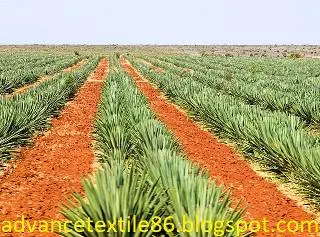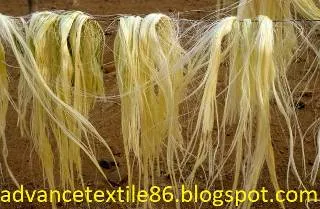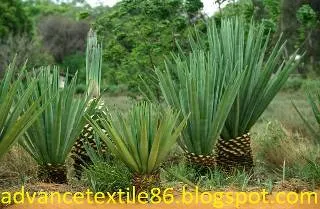Sisal fiber
Sisal
fiber has a botanical name Agave sisalana, which is a species of Agave native
to southern Mexico but widely cultivated and naturalized in many other
countries. It is found in a solid fiber used in making various products. The
term sisal can refer to the common name or fiber of a plant, depending on the
context. Sometimes it is also known as "sisal hemp" because hemp has
been a major source of fiber for centuries and other fiber sources were named
after it. Sisal fiber is traditionally used for ropes and yarns and has
many more uses, including paper, cloth, footwear, hats, bags, carpets,
geotextiles, and dartboards. It is used as a fiber integrator for composite
fiberglass, rubber, and cement products.
Properties of Sisal fiber
i.
Sisal is a leaf fiber.
ii.
It is about 1.5-2 meters tall
iii.
It has a 7-10 year life-span
iv.
It produces 200-250 commercially usable leaves.
v.
Each leaf contains around 1000 fibers.
vi.
It contains fiber about 4% of plant weight.
vii.
It is exceptionally durable with low maintenance with minimal wear and tear.
viii.
It is recyclable.
ix.
These are found on the outer leaf skin after removal
Interior
decoration.
x.
It is available in weaving as plain, herringbone, and twill.
xi.
These fibers are anti-static, do not attract or trap dust, and do not absorb
moisture or water easily.
xii.
The delicate texture looks more easily colored than the others and provides the
largest range of color shades of all-natural fibers.
xiii.
It shows good sound and effect absorbing properties.
xiv.
Its leaves can be treated with natural borax for fire resistance properties.
Chemical composition of sisal fiber
Cellulose
– (65-78) %
Hemi-cellulose
– (10-14) %
Pectin
– 10 %
Lignin
– 9.9 %
Waxes – 2 %
Plant description
Sisal
plants consist of sword-shaped leaves about 1.5–2 meters tall. The young leaves
may have teeth for a few minutes along the margins but may lose as they turn.
Sisal plants have a 7-10-year lifespan and typically produce 200-250
commercially useful leaves. Each leaf contains about 1000 fibers on average.
Fibers divide about 4% of plants by weight. Sisal is considered a plant of the
tropics and subtropics since production benefits from temperatures above 25 °C
and sunshine.
Cultivation of sisal
In the nineteenth century, sisal cultivation spread to Florida, the Caribbean
islands, and Brazil, and countries in Africa, especially Tanzania and Kenya,
and Asia. Sisal came to Africa from Florida, through the mechanics of an
extraordinary German botanist named Hinderf. Brazil's first commercial plant
was built in the late 1930s, and the first sisal fiber was exported from there
in 1948. Brazilian production did not accelerate until the 1960s, and the first
of many spinning mills were established. Today Brazil is the main producer of
sisal. Sisal growth has both positive and negative environmental effects.
Fiber processing
The
fiber is collected by a process known as decortication, where the leaves are
crushed, beaten, and a rotating wheelset is cleaned with a blunt knife so that
only the fibers remain. Differently, in East Africa, where production is large
estates, the leaves are transported to a central decortication plant, where
water is used to wash away the waste parts of the leaf.
The
fiber is then dried, brushed, and billed for export. Proper drying is important
because the quality of the fiber largely depends on the amount of moisture.
Artificial drying results in better grades of fiber than sun drying, but not
always in developing countries where sisal is produced. In the drier climate of
northeast Brazil, sisal is mainly grown by smallholders, and the fiber is
extracted by teams using portable raspadors that do not use water.
Fiber
is subsequently cleaned by brushing. The dried fibers are sorted into different
grades by scraping the machine mainly in the form of the separation size of the
anterior region of the leaves.
Uses of sisal fiber
i. Sisal
fiber is used for its low cost and specialty paper, dartboard, buffing cloth,
filters, geotextiles, mattresses, carpets, handicrafts, wire rope for core,
yarn, and general cordage.
ii.
It has been used as an environmentally-friendly strengthening agent to replace
asbestos and fiberglass in composite materials.
iii.
Its lower grade used paper industry and medium grade is used in the cordage
industry.
iv.
Its rope and twine are used in marine, agriculture, and general industry.
v.
Its higher-grade yarn is used in the carpet industry.
vi.
It is also being used to manufacture coarse fabrics, rugs. Carpets,
handicrafts, mats, fishing nets, etc.
vii.
It is also used in buildings, automobiles, railways, geotextiles, packaging
industries, etc.
viii.
These fibers are used as reinforced composite building materials like wood
substitute products, panels, doors.












0 Comments